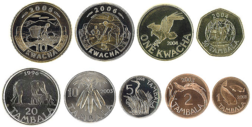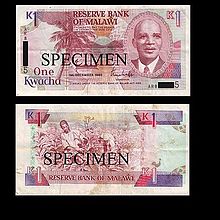- Malawian kwacha
-
Malawian kwacha 
Current coins ISO 4217 code MWK User(s)  Malawi
MalawiInflation 7.5% Source Reserve Bank of Malawi, Dec 2007. Subunit 1/100 tambala Symbol MK Coins Freq. used 1, 5, 10 kwacha Rarely used 1, 2, 5, 10, 20, 50 tambala Banknotes 5, 10, 20, 50, 100, 200, 500 kwacha Central bank Reserve Bank of Malawi Website www.rbm.mw The kwacha (ISO 4217: MWK) is the currency of Malawi as of 1971, replacing the Malawian pound. It is divided into 100 tambala. The kwacha replaced other types of currency, namely British, South African and Rhodesian, that had previously circulated through the Malawian economy. The exchange rate of the kwacha undergoes fixed periodical adjustments, but since 1994 the exchange rate has floated.[1] In 2005, administrative measures were put in place to control the exchange rate with other currencies.[2] Banknotes are issued by the Reserve Bank of Malawi.
Contents
Etymology
The name kwacha derives from both the Nyanja and Bemba word for "dawn", while tambala translates as "rooster" in Nyanja. The tambala was so named because a rooster appeared on the first one tambala coin.
History
The kwacha replaced the Malawian pound in 1971 at a rate of two kwacha to one pound.
As of 4 July 2010, one British pound sterling was equal to 227.681 kwacha, one US dollar was equal to 149.8 kwacha and one South African rand was equal to 19.4475 kwacha.
As on 9th May 2011, one British pound sterling was equal to 257.7172 kwacha, one US dollar was equal to 152.2933 kwacha and one South African rand was equal to 23.7740 kwacha.
Coins
The first coins introduced in 1971 were in denominations of one, two, five, ten and twenty tambala. In 1986, fifty tambala and one kwacha coins were also introduced. In January of 2007, five and ten kwacha coins, which actually bear a mint date of 2006, were also released into circulation.
The one and two tambala coins are composed of copper-plated steel. The five tambala coin is of nickel-plated steel. The fifty tambala and one kwacha coin are composed of brass-plated steel.[3]
Banknotes
 Old Malawian 1 kwacha note, carrying the date 1 Dec 1990, depicting former President-for-Life Hastings Banda on the front and workers in a Tobacco field on the reverse.
Old Malawian 1 kwacha note, carrying the date 1 Dec 1990, depicting former President-for-Life Hastings Banda on the front and workers in a Tobacco field on the reverse.
In 1971, banknotes were introduced in denominations of 50 tambala, 1, 2 and 10 kwacha. 5 kwacha notes were introduced in 1973 when the 2 kwacha note was discontinued. 20 kwacha notes were introduced in 1983. 50 tambala notes were last issued in 1986, with the last 1 kwacha notes printed in 1990. In 1993, 50 kwacha notes were introduced, followed by 100 kwacha in 1993, 200 kwacha in 1995 and 500 kwacha in 2001.
As of 2008, the following banknote denominations of banknotes are in circulation:
1997 Series [1] Image Value Dimensions Main Colour Description Date of first printing Obverse Reverse K5 126 × 63 mm Green John Chilembwe Villagers mashing grain 1 July 1997 K10 132 × 66 mm Brown Children in "bush" school K20 138 × 69 mm Purple Workers harvesting tea leaves K50 144 × 72 mm Blue Independence Arc in Blantyre K100 150 × 75 mm Red Capital Hill in Lilongwe K200 156 × 78 mm Blue Reserve Bank building in Lilongwe K500 Multi-colour 1 December 2001 These images are to scale at 0.7 pixels per millimetre. For table standards, see the banknote specification table. Current MWK exchange rates From Google Finance: AUD CAD CHF EUR GBP HKD JPY USD ZAR From Yahoo! Finance: AUD CAD CHF EUR GBP HKD JPY USD ZAR From OzForex: AUD CAD CHF EUR GBP HKD JPY USD ZAR From XE.com: AUD CAD CHF EUR GBP HKD JPY USD ZAR From OANDA.com: AUD CAD CHF EUR GBP HKD JPY USD ZAR See also
References
- ^ Frederic L. Pryor, The political economy of poverty, equity, and growth: Malaŵi and Madagascar Oxford University Press, 1990 ISBN 0195208234, p. 415
- ^ Annual Report on Exchange Arrangements and Exchange Restrictions , International Monetary Fund, 2006, ISBN 1589065697, p[page 716
- ^ "Malawi." NumisMaster. F+W Publications, Inc. 2011. Web. 17 February 2011.
Preceded by:
Malawian pound
Ratio: 2 kwacha = 1 poundCurrency of Malawi
1971 –Succeeded by:
CurrentCurrency: Malawian kwacha Communications Industries: Currencies of Africa North Central East Comorian franc · Djiboutian franc · Eritrean nakfa · Ethiopian birr · Kenyan shilling · Seychellois rupee · Somali shilling · Somaliland shilling (unrecognized) · South Sudanese pound · Tanzanian shilling · Ugandan shillingSouth Botswana pula (Zimbabwe) · British pound sterling (Saint Helena, Zimbabwe) · Euro (French Southern and Antarctic Lands, Mayotte, Réunion, Zimbabwe) · Lesotho loti · Malagasy ariary · Malawian kwacha · Mauritian rupee · Mozambican metical · Namibian dollar · Saint Helena pound · South African rand (Lesotho, Namibia, Swaziland, Zimbabwe) · Swazi lilangeni · U.S. dollar (Zimbabwe) · Zambian kwacha · Zimbabwean dollarWest Categories:- Currencies of Africa
- Circulating currencies
- Economy of Malawi
- 1971 establishments
Wikimedia Foundation. 2010.
